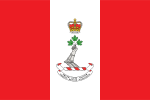Military Communications and Electronics Museum

The Military Communications and Electronics Museum (Musée de l'électronique et des communications militaires) is a military signals museum on Ontario Highway 2 at CFB Kingston in Kingston, Ontario, Canada. A member organisation of the Organization of Military Museums of Canada, the communications museum was established at the base in 1961 and moved to its current purpose-built building in 1996.Described by Lonely Planet as "a comprehensive and well-designed museum offering chronological displays on communications technology and sundry military gadgets", the museum traces the development of military communications from 1903 onward, through World War I and II, the Korean War and various NATO and United Nations peacekeeping missions to the modern era of communications satellites.
Excerpt from the Wikipedia article Military Communications and Electronics Museum (License: CC BY-SA 3.0, Authors, Images).Military Communications and Electronics Museum
Craftsman Boulevard, Kingston
Geographical coordinates (GPS) Address Website External links Nearby Places Show on map
Geographical coordinates (GPS)
| Latitude | Longitude |
|---|---|
| N 44.2423 ° | E -76.4399 ° |
Address
Military Communications and Electronics Museum
Craftsman Boulevard 95
K7K 7C1 Kingston
Ontario, Canada
Open on Google Maps





